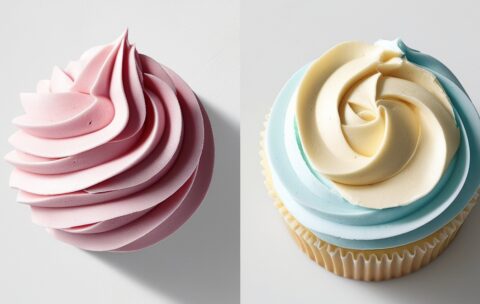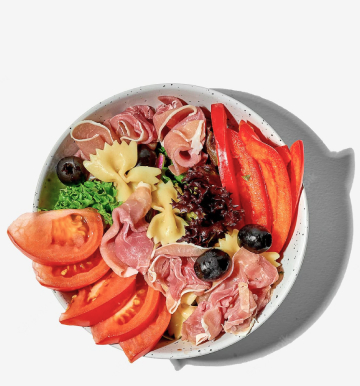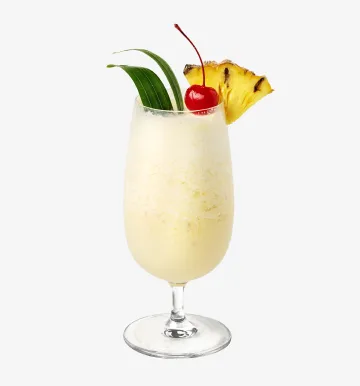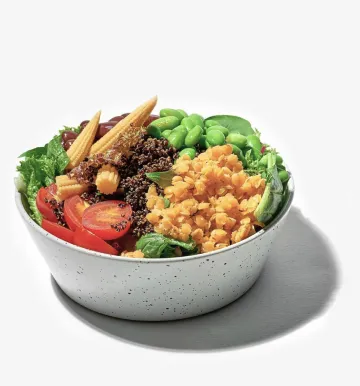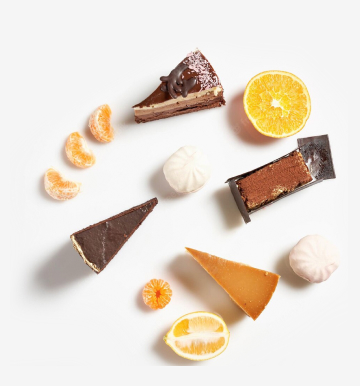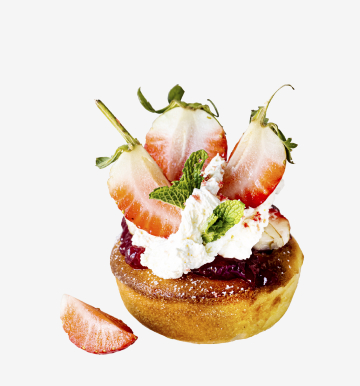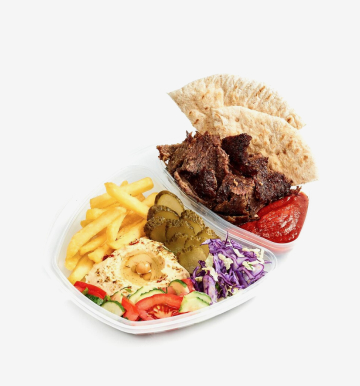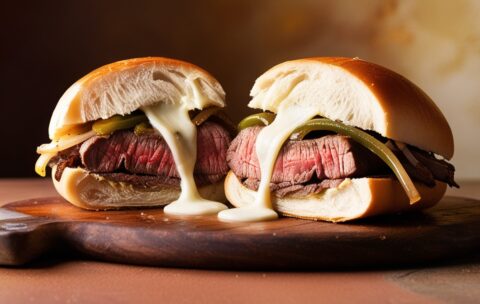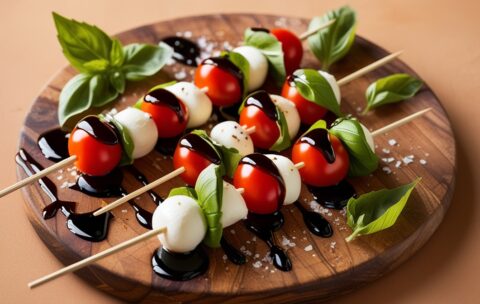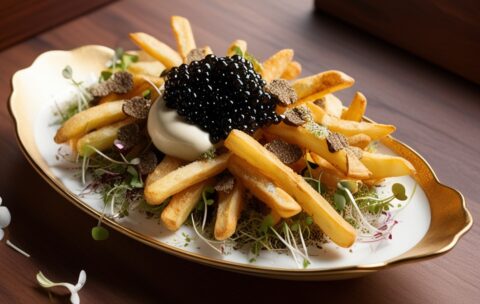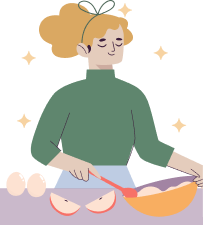Home Update 02
October 4, 2023 2025-06-05 13:04Home Update 02
Become a Home Chef
Learn to cook from scratch and master restaurant-quality meals in your own kitchen. Perfect for beginners and food lovers.

Our Top Courses
We've selected the best programs to get you started. Each course offers step-by-step lessons, hands-on recipes, and guaranteed results — even for beginners.
Beet & Goat Cheese Salad
4 Lessons
1.2 hour
Intermediate
What you'll learn
How to select and roast beets for optimal flavor and texture
Tips for achieving the perfect creamy goat cheese consistency
Preparation of a bright citrus-honey vinaigrette
Plating techniques to create a restaurant-style presentation
Nutritional benefits of beets and goat cheese
Lobster Roll with Garlic Butter
4 Lessons
3.3 hours
Intermediate
What you'll learn
How to select, buy, and cook fresh lobster meat (from boiling/steaming to picking meat).
Techniques for making flavored garlic butter (infusing with garlic, herbs, lemon zest).
Proper seasoning and temperature control to keep lobster tender and juicy.
Best practices for toasting split-top hot dog buns or brioche rolls so they hold up and absorb butter.
How to assemble and garnish a Lobster Roll (balancing textures with finely chopped celery, chives, or parsley).
Buttercream Icing Techniques
5 Lessons
59 minutes
Intermediate
What you'll learn
Buttercream Foundations: Basic ratios for American, Swiss, Italian, and French buttercreams; key differences in texture, sweetness, and stability.
Temperature Control: How to handle ingredients (room-temperature vs. chilled butter, sugar syrup stages) to prevent graininess or separation.
Flavoring & Infusing: Incorporating extracts, fruit purées, ganache, or cocoa; balancing sweetness and fat without compromising consistency.
Coloring Strategies: Best practices for gel vs. powdered colors; preventing “bleeding” or streaking when blending multiple hues (e.g., ombré or watercolor effects).
Spreading & Smoothing: Techniques for achieving glass-smooth sides (bench scraper, icing turntable, hot spatula method) and avoiding common marks or air pockets.
Piping & Decorative Textures: Creating rosettes, ruffles, ruffles, basketweave, petals, and multi-tone piping (hidden two-tone tips, reversible bags).
Stabilizing for Warm Climates: Adjusting recipes (adding meringue powder or corn syrup) so buttercream holds shape in humid or warm environments.
Troubleshooting Common Issues: Fixing grainy buttercream, curdled mixtures, overly soft or too-stiff icing; rescue methods (re-creaming, adjusting sugar syrup).
Wagyu Truffle Burger
4 Lessons
1.3 hour
Intermediate
What you'll learn
How to source authentic wagyu beef and distinguish grading (A5 vs. A3, etc.).
Techniques for gently forming wagyu patties that maintain optimal marbling and juiciness.
Methods for cleaning, slicing, and using fresh truffle, as well as alternatives like truffle oil or preserved truffle.
Seasoning balance: how much salt and pepper to enhance wagyu flavor without overpowering it.
Proper bun-to-patty ratio: selecting and toasting a buttery brioche bun to complement the richness.
Topping assembly: choosing and melting premium cheese (such as aged Gruyère or Taleggio) to pair with truffle.
Finishing touches: creating a truffle-infused aioli or mayonnaise, and adding crisp greens and caramelized onions to balance textures.
Quinoa & Kale Salad
4 Lessons
2.9 hours
Intermediate
What you'll learn
How to cook quinoa perfectly every time
Proper technique for “massaging” kale to remove bitterness
Knife skills for uniformly chopping vegetables
How to whisk together a balanced lemon–tahini dressing
Tips for seasoning and customizing the salad to taste
Strategies for storing and reheating without sogginess
Art of Fondant & Modeling Chocolate
4 Lessons
1.2 hour
Intermediate
What you'll learn
Fondant Fundamentals: How to knead, roll, and cover a cake in smooth fondant; troubleshooting common issues like tearing or cracking.
Color Mixing & Painting: Methods for achieving uniform pastel or vibrant hues using gel, powder, and airbrush techniques; blending shades for gradients and ombré effects.
Modeling Chocolate Preparation: Step-by-step process to make stable, pliable modeling chocolate at home—adjusting ratios for firmness or flexibility.
Sculpting Techniques: Building 3D elements (flowers, animals, figurines) layer by layer; using armature supports for larger models.
Texture & Embellishment: Creating realistic surface details—wood grain, lace patterns, ruffles, and draping—using molds, veiners, embossing tools, and impression mats.
Piping & Detailing: Accenting fondant and modeling chocolate pieces with royal icing, edible beads, and dusting powders to add dimension and realism.
Assembly & Structural Integrity: Best practices for attaching heavy sugar components to cake tiers; internal support systems (dowels, skewers) to ensure stability during transport and display.
Golden Chocolate Fondant
5 Lessons
3.3 hours
Intermediate
What you'll learn
Ingredient Selection & Preparation
How to choose and combine premium dark chocolate, unsalted butter, and the unique ingredient (edible gold dust) to achieve both flavor depth and visual appeal.
Proper techniques for melting and tempering chocolate to ensure smooth consistency.
Batter Creation & Consistency Control
Step-by-step guidance on mixing flour, sugar, eggs, and cocoa to create a velvety batter that bakes into a crisp exterior while preserving a molten core.
Tips for testing batter viscosity to guarantee consistently gooey centers.
Molding & Baking Techniques
Methods for greasing and flouring individual ramekins or molds so the fondants release cleanly.
Precise oven temperature and timing strategies—accounting for oven variances—to achieve the signature “golden” crust with a flowing center.
Golden Finish Application
How to incorporate edible gold dust or gold leaf: when and how to apply it so it adheres beautifully without melting or smearing.
Alternative decoration ideas (e.g., gold-dusted raspberries, gold-tinted sauce) to complement the fondant’s appearance.
Plating & Serving
Techniques for plating fondants to maximize visual impact—pairing with complementary sauces (e.g., raspberry coulis, salted caramel) and garnishes.
Recommendations on optimal serving temperature and timing to preserve the molten center for guests.
Chocolate Fondant
3 Lessons
1 hour
Intermediate
What you'll learn
Ingredient Selection & Preparation: How to choose high-quality chocolate, cocoa powder, and eggs; correctly measure and prepare ingredients for optimal texture.
Temperature Management: Techniques for melting chocolate and butter to avoid seizing or burning, including bain-marie and microwave methods.
Batter Consistency: How to achieve the right balance between a custard-like batter and a stable cake structure so that the exterior sets while the interior remains molten.
Molding & Baking: Proper greasing, flouring, or buttering of molds; timing and oven temperature adjustments to guarantee a uniform rise without overcooking.
Plating & Presentation: Tips for unmolding the fondant cleanly, garnishing ideas (e.g., dusted cocoa, fresh berries, ice cream pairing), and creating an elegant plating design.
Troubleshooting Common Issues: Solutions for common pitfalls—such as undercooked centers that are too runny, overbaked cakes with no molten core, or cracked exteriors.
Cobb Salad
6 Lessons
2.9 hours
Intermediate
What you'll learn
How to poach or grill chicken breast for optimal juiciness
Technique for rendering and crisping bacon
Proper avocado selection and slicing without browning
Making a balanced Dijon-honey vinaigrette
Layering and plating the salad for visual appeal
Variations to adapt to dietary preferences (vegetarian, gluten-free)
Mini & Individual Cake Creations
3 Lessons
3 hours
Intermediate
What you'll learn
How to scale down classic cake recipes (sponge, chiffon, pound) for smaller molds and ring cutters
Techniques for creating uniformly shaped mini cakes: using acetate sides, ring molds, and layered inserts
Methods for preparing delicate fillings—fruit compotes, chocolate ganache, and flavored mousses—suited to individual portions
Decorating approaches tailored to small canvases: tempered chocolate accents, buttercream piping, and fresh garnishes
Temperature control and timing secrets that prevent overbaking when working with small molds
Ideas for plating and packaging individual cakes to enhance presentation for events or retail
Choose Your Category
Our courses are grouped by category to help you find what suits your taste. From quick dinners to gourmet desserts — start with what inspires you.



About Our Culinary Journey
We are passionate about bringing the joy of cooking to everyone. Our mission is to empower food lovers with the skills and confidence to create delicious meals at home. With expert chefs, innovative teaching methods, and a love for culinary arts, we’re here to inspire your kitchen adventures.
Our Commitment
Everyone can cook well. Our courses offer clear guidance to ensure success for all skill levels.
Community Focus
Join our foodie community. Share creations and grow in a supportive environment.
Why Choose Our Culinary Courses?
Our courses are designed to make cooking fun, accessible, and inspiring. Whether you're a beginner or a seasoned cook, our unique features will help you elevate your skills and unleash your culinary creativity.

Expert Instructors
Learn from world-class chefs with years of experience. Our instructors guide you step-by-step, sharing professional tips.
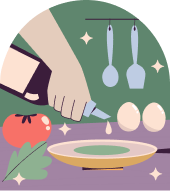
Flexible Learning
Study at your own pace, anytime, anywhere. Our online platform offers 24/7 access to lessons, so you can fit cooking into your busy schedule.

Hands-On Recipes
Practice with real recipes designed for all skill levels. From classic dishes to modern creations, you’ll master meals that impress every time.
What Our
Students Say
Hear from our happy students who have transformed their cooking skills with our courses. From beginners to seasoned cooks, our community loves sharing their success stories!
"This course completely changed how I cook! The instructors are so knowledgeable, and the lessons are easy to follow. I’m now confident making dishes I never thought I could."
Emma Johnson
"I love the flexibility of these courses. I can learn at my own pace and still feel supported. The recipes are amazing, and I’ve impressed my family with new dishes!"
Michael Chen
"The vegan cooking course was a game-changer for me. I learned so many creative ways to make plant-based meals that taste incredible. Highly recommend!"
Sophie Martinez
"The hands-on approach made learning so fun! I went from burning toast to baking artisan bread in weeks. Thank you for such an inspiring experience!"
James Carter
Discover Our Newest Culinary Courses
Get inspired by our latest additions! These exciting courses bring fresh ideas and techniques to your kitchen, perfect for food lovers eager to try something new. Browse our carousel to find your next culinary adventure.
Daiquiri
3 Lessons
59 minutes
Intermediate
What you'll learn
The origin and evolution of the Daiquiri, from early 20th-century Cuba to modern bars.
How to select and measure white rum, lime juice, and simple syrup for optimal balance.
Proper shaking technique: ice selection, shaker fill level, and pour timing.
Glassware choice and presentation tips (e.g., chilled coupe vs. Nick & Nora glass).
Simple variations (e.g., adding fruit purée or flavored syrups) while preserving the classic profile.
Mastering Chocolate Cakes
4 Lessons
1.4 hour
Intermediate
What you'll learn
Ingredient Essentials
Understanding Dutch-process vs. natural cocoa
Choosing between all-purpose, cake, and bread flour
Role of oil vs. butter for moisture
Batter Techniques
Creaming method for light layers
One-bowl “melted-chocolate” method for dense cakes
Whipping egg whites for chiffon-style chocolate cake
Baking & Structure
Oven temperature calibration and its impact on rise
Tips for level cakes: pan prep, baking strips, and testing doneness
Troubleshooting: sunken centers, gummy crumbs, uneven tops
Fillings & Frostings
Crafting silky chocolate ganache (TABLE BELOW)
Whipped chocolate buttercream vs. Swiss meringue buttercream
Simple whipped cream and mousse fillings
Decoration & Assembly
Stack and level layers with a cake comb and turntable
Smooth crumb coat, final coat, and ganache drip techniques
Simple piping (star tips) and fresh-fruit accents
Frosting Type Key Ingredients Best Use Case
Chocolate Ganache Equal parts dark chocolate & cream Drip cakes, glossy finishes
Swiss Meringue Buttercream Egg whites, sugar, butter, cocoa Stable layer cakes, rosettes
Whipped Chocolate Buttercream Butter, cocoa powder, powdered sugar, milk Light filling, quick spreads
Philly Cheesesteak
3 Lessons
3.8 hours
Intermediate
What you'll learn
How to choose and prepare the ideal cut of beef (ribeye or top round) for optimal flavor and tenderness.
Techniques for slicing steak paper-thin—even when working with untrimmed roasts—to ensure quick, even cooking.
Methods for properly caramelizing onions (and optional peppers) so they develop sweetness without burning.
The art of toasting a hoagie roll: achieving a lightly crisp exterior that still yields under melted cheese.
Cheese-melting strategies (provolone, American, or Cheez Whiz): achieving a gooey, coated consistency without overcooking.
Assembly order and timing: layering meat, onions, and cheese so each bite is balanced and warm.
Customization ideas: adding mushrooms, hot peppers, or garlic aioli to elevate traditional flavors.
Caprese Skewers with Balsamic Glaze
4 Lessons
1.8 hour
Intermediate
What you'll learn
Selecting and preparing ripe cherry tomatoes, fresh basil, and high-quality mozzarella for optimal flavor.
Assembling skewers with balanced proportions to ensure each bite features tomato, cheese, and basil.
Creating a silky balsamic glaze by reducing balsamic vinegar to the perfect viscosity.
Techniques for drizzling glaze artistically for presentation.
Storing and transporting assembled skewers without compromising texture or appearance.
Flavor pairing suggestions (e.g., adding a sprinkle of sea salt, cracked pepper, or a drizzle of olive oil).
Pulled Pork Sandwich
4 Lessons
3.3 hours
Intermediate
What you'll learn
Choosing the Right Cut: How to select a well-marbled pork shoulder (Boston butt) and understand why fat content matters for pulled pork.
Seasoning & Rubs: Crafting a balanced dry rub with spices and aromatics to build depth of flavor.
Cooking Methods: Techniques for both traditional smoker smoking (wood vs. charcoal), oven roasting, and slow-cooker approaches—pros and cons of each.
Temperature Control: Monitoring internal meat temperature, knowing when to wrap (the “Texas crutch”), and recognizing the “stall” point.
Shredding & Resting: Properly resting the cooked pork, shredding techniques (fork vs. claw), and keeping the meat moist.
BBQ Sauce Basics: Making a homemade barbecue sauce (vinegar-based, tomato-based, or mustard-based variations) and adjusting sweetness, acidity, and heat.
Sandwich Assembly: Choosing the ideal bun (brioche, kaiser roll, or potato roll), layering techniques to prevent sogginess, and adding complementary toppings (coleslaw, pickles, onions).
Plate Presentation & Storage: Tips for presentation (plating, garnishes) and storing any leftovers without losing texture or flavor.
Caviar Pommes Frites
5 Lessons
2.5 hours
Intermediate
What you'll learn
Perfect Fry Technique: Double-fry method for ultra-crisp exterior and tender interior
Caviar Handling: Proper storage, gentle scooping, and temperature control
Sauce Preparation: Whipping crème fraîche to airy perfection and seasoning
Flavor Balancing: Harmonizing the saltiness of caviar with the richness of the fry
Plating & Garnish: Artful arrangements using micro-greens, chives, and edible flowers
Coq au Vin
3 Lessons
2.3 hours
Intermediate
What you'll learn
Ingredient Selection & Preparation:
How to choose the right cut of chicken (whole, thighs, or a combination) and select complementary wine (e.g., Burgundy Pinot Noir or alternative regional varieties).
Proper techniques for trimming, seasoning, and preparing lardons, mushrooms, and root vegetables.
Braising Fundamentals:
The importance of searing chicken pieces for color and flavor development.
How to deglaze a Dutch oven or heavy-bottomed casserole with red wine, preserving all the fond (browned bits) on the pan bottom.
Flavor-Building Strategies:
Layering aromatics—onion, garlic, carrot, thyme, and bay leaf—to create depth.
Controlling heat and timing for a slow, gentle simmer that yields tender meat and a concentrated sauce.
Sauce Reduction & Finishing Touches:
Techniques for skimming excess fat and reducing the braising liquid to a velvety consistency.
Tips for adding mushrooms and optional garnishes (parsley, fresh herbs) at the final stage for maximum aroma and texture.
Plating & Serving Suggestions:
How to present Coq au Vin with traditional accompaniments (e.g., buttered noodles, mashed potatoes, crusty bread).
Strategies for reheating or holding the dish without sacrificing quality, making it ideal for dinner parties.
Moroccan Orange & Olive Salad
6 Lessons
1.6 hour
Intermediate
What you'll learn
How to segment oranges for a clean, pith-free presentation
Techniques for balancing sweet citrus with salty olives and spicy harissa
Crafting a cumin-infused vinaigrette and emulsifying dressings
Proper knife skills for uniform onion slicing and olive prep
Caprese Salad
6 Lessons
2.3 hours
Intermediate
What you'll learn
How to select perfectly ripe tomatoes and fresh mozzarella
Techniques for uniform slicing and layering
Balancing flavors with olive oil, balsamic vinegar, salt, and pepper
Creative garnishes and presentation ideas
Tips for make-ahead prep without sacrificing freshness
Quinoa & Kale Salad
4 Lessons
2.9 hours
Intermediate
What you'll learn
How to cook quinoa perfectly every time
Proper technique for “massaging” kale to remove bitterness
Knife skills for uniformly chopping vegetables
How to whisk together a balanced lemon–tahini dressing
Tips for seasoning and customizing the salad to taste
Strategies for storing and reheating without sogginess



